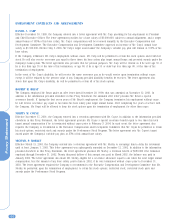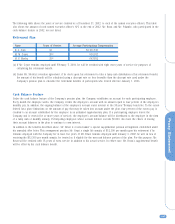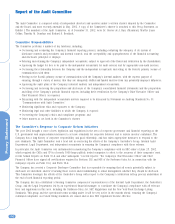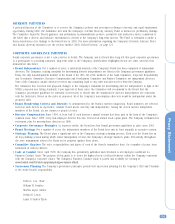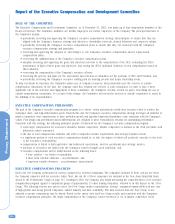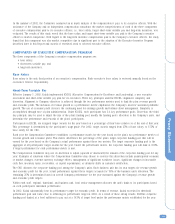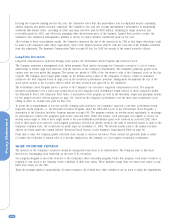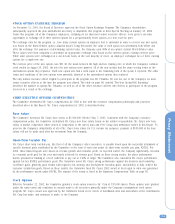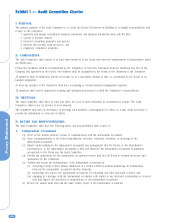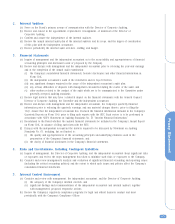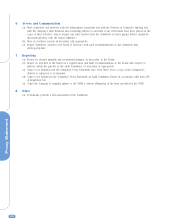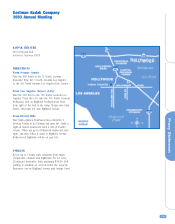Kodak 2002 Annual Report Download - page 117
Download and view the complete annual report
Please find page 117 of the 2002 Kodak annual report below. You can navigate through the pages in the report by either clicking on the pages listed below, or by using the keyword search tool below to find specific information within the annual report.
Proxy Statement
112
In fixing the corporate funding pool for the year, the Committee noted that this performance was accomplished despite continuing
difficult industry and global economic conditions. The Committee also took into account management’s performance in maintaining
worldwide film market share, exceeding its 2002 operating cash flow plan by $658 million, satisfying its target inventory and
receivables goals for 2002, and effectively managing other discretionary parts of the business. Against these positive results, the
Committee also considered management’s inability to satisfy its target customer satisfaction goals for the year.
After looking at these extraordinary results, the Committee increased the size of the award pool by 12% so that larger allocations could
be made to the Company’s units where appropriate. None of the named executive officers, with the exception of Mr. Palumbo, benefited
from this adjustment. The Summary Compensation Table on page 96 lists for 2002 the awards to the named executive officers.
Long-Term Incentives
Long-term compensation is delivered through stock options, the Performance Stock Program and restricted stock.
The Company maintains a management stock option program. Stock options encourage the Company’s executives to act as owners,
which helps to further align their interests with the interests of the Company’s shareholders. The Committee generally grants stock
options once per year under this program. The options are priced at 100% of the fair market value of the Company’s stock on the day
of grant. The Company bases target grant ranges on the median survey values of the companies it surveys. Grants to individual
executives are then adjusted based in large part on the executive’s performance potential. Management recommends the size of the
stock option awards to the executive officers which are then reviewed and approved by the Committee.
The Performance Stock Program places a portion of the Company’s top executives’ long-term compensation at risk. The program
measures performance over a three-year period based on the Company’s total shareholder return relative to those companies within
the Standard & Poor’s 500 Composite Price Index. A description of the program, as well as the threshold, target and maximum awards
for the named executive officers appears on page 101. Based on the Company’s performance over the three-year performance cycle
ending in 2002, no awards were paid for this cycle.
To incent the accomplishment of several, specific Company-wide objectives, the Committee approved a one-time, performance-based,
long-term award program, i.e., the Executive Incentive Program, under the 2002-2004 cycle of the Performance Stock Program. A
description of the Executive Incentive Program appears on page 100. The program contains an interim award opportunity to encourage
its participants to achieve the program’s goals before year-end 2003. Under this feature, each participant was eligible to receive an
interim award equal to 30% of their target award if two pre-established performance goals were achieved by year-end 2002. Since
both of these goals were achieved, each program participant received an interim award in the form of restricted shares or units of the
Company’s common stock, the restrictions on which lapse on December 31, 2003. The interim awards paid to the named executive
officers are listed under the column entitled “Restricted Stock Awards” in the Summary Compensation Table on page 96.
From time to time, the Company grants restricted stock awards to selected executives. These awards are generally made to either
(1) induce the recipients to remain with or to become employed by the Company; or (2) recognize exceptional performance.
SHARE OWNERSHIP PROGRAM
The interests of the Company’s executives should be inseparable from those of its shareholders. The Company aims to link these
interests by encouraging stock ownership on the part of its executives.
One program designed to meet this objective is the Company’s share ownership program. Under this program, each senior executive is
required to own stock of the Company worth a multiple of their base salary. These multiples range from one times base salary to four
times base salary for the CEO.
Today, the program applies to approximately 20 senior executives, all of whom have either satisfied or are on track to satisfy the requirements.


